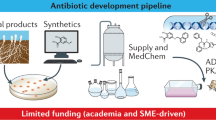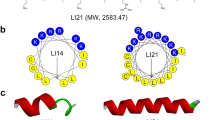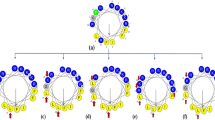Abstract
Over the past decade, the availability of complete microbial genome sequences has led to changes in the strategies that are used to search for novel anti-infectives. However, despite the identification of many new potential drug targets, novel antimicrobial agents have been slow to emerge from these efforts. In part, this reflects the long discovery and development times that are needed to bring new drugs to market and the bottlenecks at the stages of identifying good lead compounds and optimizing these leads into drug candidates. Structural genomics will hopefully provide opportunities to overcome these bottlenecks and populate the antimicrobial pipeline.
This is a preview of subscription content, access via your institution
Access options
Subscribe to this journal
Receive 12 print issues and online access
$209.00 per year
only $17.42 per issue
Buy this article
- Purchase on Springer Link
- Instant access to full article PDF
Prices may be subject to local taxes which are calculated during checkout



Similar content being viewed by others
References
Wilson, J. C. & von Itzstein, M. Recent strategies in the search for new anti-influenza therapies. Curr. Drug Targets 4, 389–408 (2003).
Hardy, L. W. & Maliyakil, A. The impact of structure-guided drug design on clinical agents. Curr. Drug Discov. [online] <http://www.currentdrugdiscovery.com/pdf/2003/515563.pdf> (2003).
Wimberly, B. T. et al. Structure of the 30S ribosomal subunit. Nature 407, 327–339 (2000).
Yusupov, M. M. et al. Crystal structure of the ribosome at 5.5 Å resolution. Science 292, 883–896 (2001).
Ban, N., Nissen, P., Hansen, J., Moore, P. B. & Steitz, T. A. The complete atomic structure of the large ribosomal subunit at 2.4 Å resolution. Science 289, 905–920 (2000).
Murakami, K. S., Masuda, S. & Darst, S. A. Structural basis of transcription initiation: RNA polymerase holoenzyme at 4 Å resolution. Science 296, 1280–1284 (2002).
Lim, D. & Strynadka, N. C. Structural basis for the β-lactam resistance of PBP2a from methicillin-resistant Staphylococcus aureus. Nature Struct. Biol. 9, 870–876 (2002).
Bellon, S. et al. Crystal structures of Escherichia coli topoisomerase IV ParE subunit (24 and 43 kilodaltons): a single residue dictates differences in novobiocin potency against topoisomerase IV and DNA gyrase. Antimicrob. Agents Chemother. 48, 1856–1864 (2004).
Tsai, F. T. et al. The high-resolution crystal structure of a 24-kDa gyrase B fragment from E. coli complexed with one of the most potent coumarin inhibitors, clorobiocin. Proteins 28, 41–52 (1997).
Bower, J. et al. Structure-based design of agents targeting the bacterial ribosome. Bioorg. Med. Chem. Lett. 13, 2455–2458 (2003).
Fleischmann, R. D. et al. Whole-genome random sequencing and assembly of Haemophilus influenzae Rd. Science 269, 496–512 (1995).
Zalacain, M. et al. A global approach to identify novel broad-spectrum antibacterial targets among proteins of unknown function. J. Mol. Microbiol. Biotechnol. 6, 109–126 (2004).
Akerley, B. J. et al. A genome-scale analysis for identification of genes required for growth or survival of Haemophilus influenzae. Proc. Natl Acad. Sci. USA 99, 966–971 (2002).
Jacobs, M. A. et al. Comprehensive transposon mutant library of Pseudomonas aeruginosa. Proc. Natl Acad. Sci. USA 100, 14339–14344 (2003).
Gerdes, S. Y. et al. Experimental determination and system level analysis of essential genes in Escherichia coli MG1655. J. Bacteriol. 185, 5673–5684 (2003).
Forsyth, R. A. et al. A genome-wide strategy for the identification of essential genes in Staphylococcus aureus. Mol. Microbiol. 43, 1387–1400 (2002).
Sittampalam, G. S., Kahl, S. D. & Janzen, W. P. High-throughput screening: advances in assay technologies. Curr. Opin. Chem. Biol. 1, 384–391 (1997).
Silverman, L., Campbell, R. & Broach, J. R. New assay technologies for high–throughput screening. Curr. Opin. Chem. Biol. 2, 397–403 (1998).
Zhang, L. et al. Regulated gene expression in Staphylococcus aureus for identifying conditional lethal phenotypes and antibiotic mode of action. Gene 255, 297–305 (2000).
Payne, D. et al. Discovery of a novel and potent class of FabI-directed antibacterial agents. Antimicrob. Agents Chemother. 46, 3118–3124 (2002).
DeVito, J. A. et al. An array of target-specific screening strains for antibacterial discovery. Nature Biotechnol. 20, 478–483 (2002).
Bostian, K. A. & Schmid, M. B. in Antibacterial Therapy: Achievements, Problems and Future Perspectives (eds Busse, W. D., Zeiler, H. J. & Labischinski, H.) 61–68 (Springer Verlag, Berlin, 1997).
Ji, Y. et al. Validation of antibacterial mechanism of action using regulated antisense RNA expression in Staphylococcus aureus. FEMS Microbiol. Lett. 231, 177–184 (2004).
Hou, J., Sims, G. E., Zhang, C. & Kim, S. H. A global representation of the protein fold space. Proc. Natl Acad. Sci. USA 100, 2386–2390 (2003).
Service, R. F. Structural genomics. Tapping DNA for structures produces a trickle. Science 298, 948–950 (2002).
Berman, H. M. et al. The Protein Data Bank. Nucleic Acids Res. 28, 235–242 (2000).
Lesley, S. A. et al. Structural genomics of the Thermotoga maritima proteome implemented in a high-throughput structure determination pipeline. Proc. Natl Acad. Sci. USA 99, 11664–11669 (2002).
Christendat, D. et al. Structural proteomics of an archaeon. Nature Struct. Biol. 7, 903–909 (2000).
Goulding, C. W. & Perry, L. J. Protein production in Escherichia coli for structural studies by X–ray crystallography. J. Struct. Biol. 142, 133–143 (2003).
Vincentelli, R. et al. Medium-scale structural genomics: strategies for protein expression and crystallization. Acc. Chem. Res. 36, 165–172 (2003).
Gerstein, M. Patterns of protein-fold usage in eight microbial genomes: A comprehensive structural census. Proteins 33, 518–534 (1998).
Derewenda, Z. S. Rational protein crystallization by mutational surface engineering. Structure 12, 529–535 (2004).
Goulding, C. W. et al. Structural genomics of Mycobacterium tuberculosis: a preliminary report of progress at UCLA. Biophys. Chem. 105, 361–370 (2003).
Gerstein, M., Edwards, A., Arrowsmith, C. H. & Montelione, G. T. Structural genomics: current progress. Science 299, 1663 (2003).
Westbrook, J., Feng, Z., Chen, L., Yang, H. & Berman, H. M. The protein data bank and structural genomics. Nucleic Acids Res. 31, 489–491 (2003).
Makrides, S. C. Strategies for achieving high-level expression of genes in Escherichia coli. Microbiol Rev. 60, 512–538 (1996).
Jancarik, J. & Kim, S. -H. Sparse matrix sampling: a screening method for crystallization of proteins. J. Appl. Cryst. 24, 409–411 (1991).
Kimber, M. S. et al. Data mining crystallization databases: knowledge-based approaches to optimize protein crystal screens. Proteins 51, 562–568 (2003).
Goh, C. S. et al. Mining the structural genomics pipeline: identification of protein properties that affect high-throughput experimental analysis. J. Mol. Biol. 336, 115–130 (2004).
Hosfield, D. et al. A fully integrated protein crystallization platform for small molecule drug discovery. J. Struct. Biol. 142, 207–217 (2003).
Chayen, N. E. Protein crystallization for genomics: throughput versus output. J. Struct. Funct. Genomics 4, 115–120 (2003).
Rupp, B. High-throughput crystallography at an affordable cost: the TB structural genomics consortium crystallization facility. Acc. Chem. Res. 36, 173–181 (2003).
Moult, J., Fidelis, K., Zemla, A. & Hubbard, T. Critical assessment of methods of protein structure prediction (CASP)-round V. Proteins 53, S334–S339 (2003).
Venclovas, C., Zemla, A., Fidelis, K. & Moult, J. Assessment of progress over the CASP experiments. Proteins 53, S585–S595 (2003).
DeWeese-Scott, C. et al. Molecular modeling of protein function regions. Proteins 55, 942–961 (2004).
Daines, R. A. et al. First X-ray co-crystal structure of a bacterial FabH condensing enzyme and a small molecule inhibitor achieved using rational design and homology modeling. J. Med. Chem. 46, 5–8 (2003).
Sharff, A. & Jhoti, H. High-throughput crystallography to enhance drug discovery. Curr Opin. Chem. Biol. 7, 340–345 (2003).
Whittington, D. A., Rusche, K. M., Shin, H., Fierke, C. A. & Christianson, D. W. Crystal structure of LpxC, a zinc-dependent deacetylase essential for endotoxin biosynthesis. Proc. Natl Acad. Sci. USA 100, 8146–8150 (2003).
Burley, S. K. The FAST and the curious: fragment-based lead discovery and optimization via high-throughput X-ray crystallography. Modern Drug Discov. 7, 53–55 (2004).
Hajduk, P. J. et al. A strategy for high-throughput assay development using leads derived from nuclear magnetic resonance-based screening. J. Biomol. Screen 7, 429–432 (2002).
Erlanson, D. A., McDowell, R. S. & O'Brien, T. Fragment-based drug discovery. J. Med. Chem. 47, 3463–3482 (2004).
Nienaber, V. L. et al. Discovering novel ligands for macromolecules using X-ray crystallographic screening. Nature Biotechnol. 18, 1105–1108 (2000).
Sanders, W. J. et al. Discovery of potent inhibitors of dihydroneopterin aldolase using CrystaLEAD high-throughput X-ray crystallographic screening and structure-directed lead optimization. J Med Chem. 47, 1709–1718 (2004).
Kline, T. et al. Potent, novel in vitro inhibitors of the Pseudomonas aeruginosa deacetylase LpxC. J. Med. Chem. 45, 3112–3129 (2002).
Onishi, H. R. et al. Antibacterial agents that inhibit lipid A biosynthesis. Science 274, 980–982 (1996).
Chen, M. H. et al. Carbohydroxamide-oxalidonones: antibacterial agents that target lipid A biosynthesis. Bioorg. Med. Chem. Lett. 9, 313–318 (1999).
Coggins, B. E., Li, X., Hindsgaul, O., Raetz, C. R. & Zhou, P. Assignment of the 1H, 13C and 15N resonances of the LpxC deacetylase from Aquifex aeolicus in complex with the substrate-analog inhibitor TU-514. J. Biomol NMR 28, 201–202 (2004).
Coggins, B. E. et al. Structure of the LpxC deacetylase with a bound substrate-analog inhibitor. Nature Struct. Biol. 10, 645–651 (2003).
Qiu, X. et al. Crystal structure of Staphylococcus aureus tyrosyl-tRNA synthetase in complex with a class of potent and specific inhibitors. Protein Sci. 10, 2008–2016 (2001).
Payne, D. J. et al. Discovery of a novel and potent class of FabI-directed antibacterial agents. Antimicrob. Agents Chemother. 46, 3118–3124 (2002).
Chen, L. et al. TargetDB: a target registration database for structural genomics projects. Bioinformatics (in the press).
Balzarini, J. Current status of the non-nucleoside reverse transcriptase inhibitors of human immunodeficiency virus type 1. Curr. Top. Med. Chem. 4, 921–944 (2004).
Nezami, A. & Freire, E. The integration of genomic and structural information in the development of high affinity plasmepsin inhibitors. Int. J. Parasitol. 32, 1669–1676 (2002).
Stammers, D. K. et al. 2.0 Å X-ray structure of the ternary complex of 7,8-dihydro-6-hydroxymethylpterinpyrophosphokinase from Escherichia coli with ATP and a substrate analogue. FEBS Lett. 456, 49–53 (1999).
Smith, C. V. & Sacchettini, J. C. Mycobacterium tuberculosis: a model system for structural genomics. Curr. Opin. Struct. Biol. 13, 658–664 (2003).
Abergel, C. et al. Structural genomics of highly conserved microbial genes of unknown function in search of new antibacterial targets. J. Struct. Funct. Genomics 4, 141–157 (2003).
Wang, R., Fang, X., Lu, Y. & Wang, S. The PDBbind database: collection of binding affinities for protein–ligand complexes with known three-dimensional structures. J. Med. Chem. 47, 2977–2980 (2004).
Acknowledgements
The author thanks former colleagues at Affinium Pharmaceuticals for the opportunity to participate in building a structural genomics pipeline and to understand the value that structural biology can bring to drug discovery when it can keep pace with the medicinal chemistry cycle. In addition, J. Berman, D. Biek, A. Dharamsi, N. Kaplan and R. Lam provided excellent comments on drafts of the manuscript.
Author information
Authors and Affiliations
Ethics declarations
Competing interests
I am a former employee of Affinium Pharmaceuticals, a structure-guided drug discovery company.
Related links
Related links
DATABASES
Entrez
Protein Data Bank
FURTHER INFORMATION
Rights and permissions
About this article
Cite this article
Schmid, M. Seeing is believing: the impact of structural genomics on antimicrobial drug discovery. Nat Rev Microbiol 2, 739–746 (2004). https://doi.org/10.1038/nrmicro978
Issue Date:
DOI: https://doi.org/10.1038/nrmicro978
This article is cited by
-
Design, synthesis and mode of action of novel 2-(4-aminophenyl)benzothiazole derivatives bearing semicarbazone and thiosemicarbazone moiety as potent antimicrobial agents
Medicinal Chemistry Research (2016)
-
Nanoliter-Scale Protein Crystallization and Screening with a Microfluidic Droplet Robot
Scientific Reports (2014)
-
Structure-based discovery of antibacterial drugs
Nature Reviews Microbiology (2010)
-
Preservation of protein clefts in comparative models
BMC Structural Biology (2008)
-
Toxic mechanisms
Nature Reviews Microbiology (2004)



